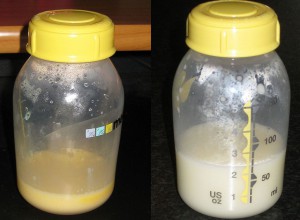Welcome to the start of World Breastfeeding Week! Breastfeeding is the natural way for mothers to provide their babies with the key nutrients they require for healthy growth and development.
To mark this week, we’ve put together a list of 10 things you might not know about breastfeeding taken from International Breastfeeding Journal.

10 things you might not know about breastfeeding:
1. Exclusive breastfeeding for the first 6 months of life reduces infant deaths and is cost effective
A recently published study by Nemat Hajeebhoy and colleagues into breastfeeding practices and infant illness in Vietnam found early initiation and exclusive breastfeeding has a protective effect against diarrhea and acute respiratory syndrome (ARI), with the effect for ARI appearing to remain constant as the child gets older.
The World Health Organization actively promotes breastfeeding as the best source of nourishment for babies and young children and stresses the importance of exclusive breastfeeding for the first six months.
2. Mothers may mistakenly consider colostrum to be dirty or unclean: Papua New Guinea
Towards the end of pregnancy mothers produce a nutrient rich substance called ‘colostrum’, which contains antibodies that fight against infection and has a low fat, high protein content in comparison to normal milk. Colostrum may last between 3-7 days after birth.

A study by Jerzy Kurma found that most explanations given by mothers for refusing to feed their babies colostrum were connected with cultural beliefs that “colostrum may harm the baby”.
Colostrum was described as “dirty”, “unclean”, “contained infected pus”, “waste from mother’s body”, “not food for the baby”, and “infectious to a child and can cause yellow eyes”. In order to combat these perceptions, women should be educated at antenatal clinics and breastfeeding promotion should target the large proportion of women who missed formal education about breastfeeding in school.
3. Partner support increases mothers’ confidence with breastfeeding- at least in Canada
This study by Cynthia Mannion and colleagues showed that women felt more capable and confident about breastfeeding when they felt their partners were supportive. Partners who encouraged them verbally and were actively involved in helping them to breastfeed were the ones seen as showing this support.
In contrast, those who perceived their partners as ambivalent or negative about breastfeeding, felt, perhaps not surprisingly, less confident in their ability to breastfeed.
4. Telephone support empowers new mothers to breastfeed: UK
Breastfeeding helplines are a popular method for callers to receive support and information; with the introduction of a National Breastfeeding Helpline within the UK leading to a large increase in callers.
Nicola Crossland and Gill Thomson showed that whilst the telephone support did not necessarily influence women’s breastfeeding decisions, the support they received left them feeling reassured, confident and more determined to continue breastfeeding.
5. Skin-to-skin contact during breastfeeding seems to produce happy feelings for mum and shortens time to resolve latch-on problems for baby
Research by Kristin Svensson and colleagues showed that skin-to-skin contact during breastfeeding seems to immediately enhance maternal positive feelings and shorten the time it takes to resolve severe latch-on problems. This may be due to skin-to-skin contact with the mother during breastfeeding having a calming effect on babies and relieving stress.
6. Health professionals should deliver services in a culturally appropriate and sensitive manner
Natasha Maharaj and Mridula Bandyopadhyay set out to find how cultural beliefs and identity influence breastfeeding practices amongst Indian immigrants in Australia.
They concluded that lack of social and cultural networks for immigrants prevents them from re-enacting traditional practices and customs relating to childbirth, particularly breastfeeding. Therefore healthcare professionals should help to empower women by delivering services in a culturally appropriate and sensitive way in those cultures which traditionally support breastfeeding, which will help to bestow women with a sense of pride in their ethnic identity.
7. Lifetime duration of lactation was associated with long term reduced cardiovascular risk in mothers aged 50 years or less
Siv Natland and colleagues found an association between breastfeeding and a more favourable cardiovascular risk profile in mothers later on in life and in particular those aged 50 years or younger. Therefore, lactation may reduce the adverse pregnancy-related changes in cardiovascular risk factors, with effects lasting even beyond the childbearing years. More studies are required to confirm this finding.
8. A combination of exclusive breastfeeding and use of antiretroviral treatment can significantly reduce the risk of transmitting HIV to babies through breastfeeding
Infant feeding by HIV-infected mothers has been a major global public health dilemma and a highly controversial matter. This thematic series, ‘Infant feeding and HIV: lessons learnt and ways ahead’, edited by Karen Moland and Astrid Blystad, highlights the multiple challenges that HIV-infected women, infant feeding counsellors and health systems have encountered trying to translate and implement the shifting infant feeding recommendations in different local contexts in sub-Saharan Africa.
9. Breastfeeding and exercise can reduce maternal stress and decrease depression
The old paradigm described inflammation as simply one of many risk factors for depression, however inflammation has been found to not be a risk factor but the risk factor that underlies all the others. This is particularly true for postpartum depression.
This review article by Kendall-Tackett found that women during and after pregnancy are particularly vulnerable to this effect because their levels of proinflammatory cytokines increased during the last trimester of pregnancy – where they are also at risk for depression. Breastfeeding has a protective effect on maternal mental health because it decreases stress and modulates the inflammatory response.
10. Last but not least – have you heard that the cyber version of wet nursing is flourishing over the internet?!
Milk sharing is nothing new – wet nurses have fed other women’s children since ancient times. Today, tech-savvy mothers are sharing milk over the internet. This involves lactating women providing their milk to infants not biologically related to them. This review article by James Akre, Karleen Gribble and Maureen Minchin acknowledges that there is potential for expanding the world’s supply of human milk and improving infant and child health. This certainly provides food for thought!

Comments